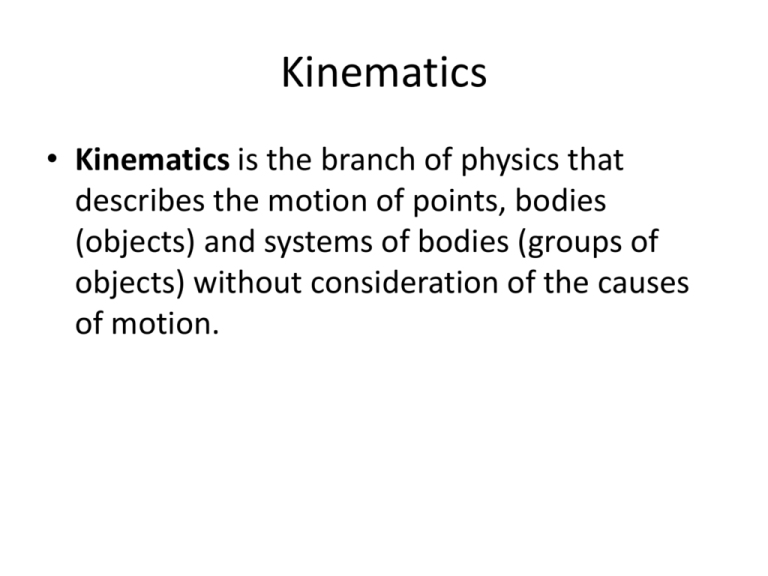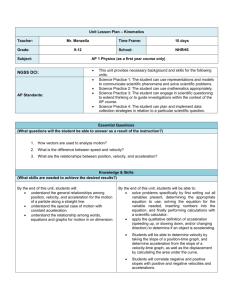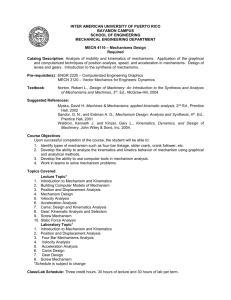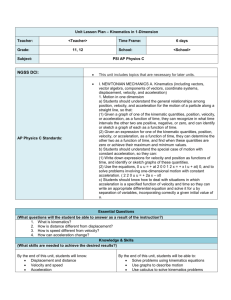Kinematics
advertisement

Kinematics • Kinematics is the branch of physics that describes the motion of points, bodies (objects) and systems of bodies (groups of objects) without consideration of the causes of motion. Kinematics • Relative motion - All motion is relative. Right now we appear to be motionless relative to each other. Kinematics • If an observer from space to look at us, he would realize that we actually are in motion. Where moving because we are viewers which is rotating, were also on the earth which is moving around the sun, the sun is moving through the Milky Way, and so on. Kinematics • We appear to be motionless relative to each other, because we are moving together. We say that we are in the same frame of reference. Kinematics • In this course we will be talking only about motion of objects relative to the surface of the earth unless otherwise stated. Kinematics • Speed is a measure of how fast something is moving . It is measured in terms of a unit of distance divided by a unit of time. Examples are: m • meters per second s mi • miles per hour h km • kilometers per hour h • The word “per” means “divided by”. Kinematics • Instantaneous speed is a speed at any given instant. It is the speed read by the speedometer in your car. • Average speed is the total distance covered divided by the time interval required to cover that distance. total distance covered average speed = time interval Kinematics • Example: You travel a distance of 100 miles during the time of two hours. What is your average speed? total distance covered average speed = time interval 100mi 50mi average speed = = 2h h Kinematics • In physics speed and velocity mean two different things. • Velocity means speed in a given direction. • If we say a car is moving at 60 km/h we are talking about speed. Speed is a scalar quantity. It is characterized only by magnitude. • If we say a car is moving at 60 km/h north we are talking about velocity. Velocity is a vector quantity. It is characterized by magnitude and direction. Kinematics • In order for an object to be moving with constant velocity its speed must be constant, and its direction must also be constant. • If either the speed and direction of a moving object is changing, then it's moving with changing velocity. Kinematics Acceleration • Acceleration is defined as change in velocity per time interval change in velocity aceleration = time interval Kinematics Acceleration • For motion in a straight line change in speed aceleration = time interval Kinematics Acceleration • Units for acceleration. distance change in velocity time interval distance acceleration = = time interval time interval time interval time interval Kinematics Acceleration is a vector quantity. It has both magnitude and direction Kinematics Example: A motorcycle is traveling north at 20 m/s. At the end of two seconds it's velocity is 40 m/s North. What was its acceleration during the two seconds? Kinematics Solution: m m m change in velocity= 40 20 20 north s s s time interval= 2s m 20 m s acceleration= 10 2 2s s Kinematics m m m change in velocity= 40 20 20 north s s s time interval= 2s m 20 m s acceleration= 10 2 2s s Kinematics Distance is a scalar measure of the interval between two locations measured along the actual path connecting them. Displacement is a vector measure of the interval between two locations measured along the shortest path connecting them. Kinematics Mathematical relationships between distance speed velocity and acceleration. We will use the following symbols: An arrow above a symbol indicates that it is a vector quantity d distance d displacement v = speed v = velocity a = acceleration t = time Kinematics The basic relationships d v = t d v = t a = v t Kinematics For a situation where the initial speed or the initial velocity is equal to zero, the following relationships hold. vt = d vt = d 1 2 d = at v at 2 2d a 2 t Kinematics When an object is in free fall it means that the only force acting on it is the force of gravity. On earth this means that we must ignore the resistance of air. This is a good approximation if an object has a small surface area, a high density, and is not moving very fast. For example the approximation works well for a dropped steel sphere, but not for a dropped tissue. Kinematics Near the surface of the earth a falling object accelerates downward with a constant acceleration. This acceleration is equal to 9.81 sm . m 10 Frequently we use a rounded value of s for calculations. This acceleration is referred to as acceleration due to gravity and is represented by a lowercase g. 2 2 In the case of free fall instead of using a for acceleration we use g in the previous equations.






